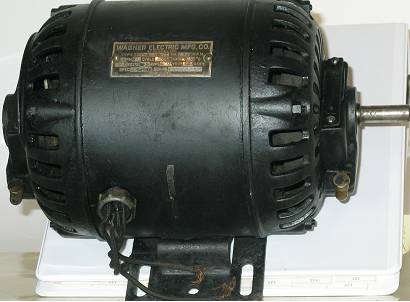Electric Motors – Single Phase, Repulsion Induction and Repulsion Motors
An early 20th century, repulsion induction, brush lifting, 25 cycle motor, manufactured in Canada for Kelvinator’s pioneering generation of cabinet refrigerators for the home. With bronze bearings and short, snap cap oilers, open ventilated, cast iron frame, and slotted 4 bolt, rigid steel base, it stands as a rare time piece in the evolution of the Canadian FHP motor and refrigeration industries, Wagner, 1928.
Features:
– 3 original manufacturers shipping tags
Technical Significance:
– A rare glimpse of the earliest years of Canadian commercial production of repulsion induction, FHP, single phase, motor technology. In spite of the engineering and manufacturing challenges faced, the development was spurred on by the promise of ever increasing market demand for high starting torque motors for home and commercial applications.
– The technology, complete with centrifugally operated brush lifters [to reduce wear and noise], and armature short circuiting mechanism [to convert from repulsion start to induction run operation] represented a truly astonishing level of research and development, and manufacturing know how, all in an era with little theory and practical experience to draw on.
– The bearing oiling system, engineered without extended oiler tubes, stands as an example of early consumer product development, with little regard for public safety. Many fingers would get caught in pulleys and fan blades before extension safety oiler tubes would become common place [see for example ID# 301 to 307]. With the ever-increasing range and sophistication of electro-motive devices for home use would come increasingly stringent safety requirements with the regulatory agencies needed to enforce them. By the end of the century substantial space in customer owning and operating manuals would be given over to safety precautions.
– Repulsion induction motor technology was above all a marvel of its time, a technology born of both science and the consumer market place, a classic formula for the innovation and diffusion of popular technology, throughout the balance of the 20th century and on in to the 21st. Scientifically, the work of Faraday and many others laid much of the theoretical foundations for electromagnetic devices, the marvel of the early 20th century [much in the same way digital devices became the marvel of the early years of the 21st]. The wonders made possible by alternating current energised, rotating magnetic fields and the electric and magnetic circuitry that made them possible would soon be exploited by those interested in their application in applied electro-motive technology, including Steinnmetz and others. [See References especially #I, 2, and 5]
– For the Canadian household and commercial refrigeration industry, pioneered by Kelvinator and Frigidaire, it would be a “just-in-time” technology, as well as an immensely enabling one – and what it enabled was considerable. Sir William Thompson, Lord Kelvin, had just set out the theoretical principles of the compression refrigeration, Carnot cycle [see Note #1]. But there existed no electro-motive devices with sufficient starting torque able to drive the compressor, making mechanical cooling practical for household and commercial uses – even for those who were otherwise able to enjoy the benefits of electrification. The push was on to develop such a device, the repulsion induction, single-phase motor would quickly follow.
– But paradoxically, by the mid 20th century the market for high torque, repulsion induction motors, for household and commercial refrigeration applications had peaked. A technology of its times, it represented immense achievement by early 20th century engineers and manufactures. Yet, as is typically the case, with the innovation, dissemination and popularization of technology come the seeds of its own demise. The very means by which its high torque performance had been achieved, through the use of an elaborate wound rotor, commentator and electrical brushes, made it costly, clumsy and noisy, as well as unsuitable for many embedded applications, such as hermetic refrigeration and air conditioning systems. Replacing the commentator and complex rotor windings with a “solid state, squirrel cage” rotor represented a giant engineering advancement. The development of capacitor start electric motor technology [see Classification 12.02] would now quickly replace repulsion induction technology for many applications, well before the end of the 20th century.
Industrial Significance:
– Canadian made, this motor would stand as a marker of the earliest years of FHP, single phase, electric motor manufacturing in the country. It would be spurred on by the promise of new market opportunities for electro-mechanical home appliances,
– The oil soaked service tags, still attached to the motor after close to 80 years, tell a number of stories of their life and times:
1. Of constant oil spillage, typically running over the floor of a Canadian kitchen somewhere, the result of over oiling of motor bearings and leaking refrigeration compressor seals. The sealed motor compressor unit could not come too soon for many home owners.
2. Of the 20 some odd service centres across Canada, established to support the service of Wagner motors and Kelvinator cabinet refrigerators, as early as 1928
3. Of the four-year replacement program, which Kelvinator maintained to promote the quality and reliability of the cabinet refrigerators they marketed to wary homeowners, as early as the 1920’s.
– Because of the specialized nature of the technology, engineering and production costs, and the limited market, few companies would be seen as surviving in the popular, repulsion induction market beyond mid century.


